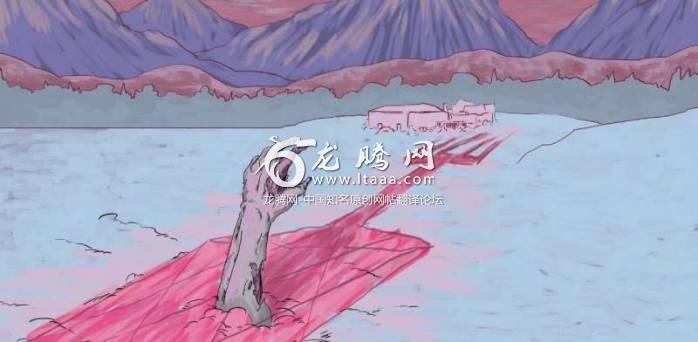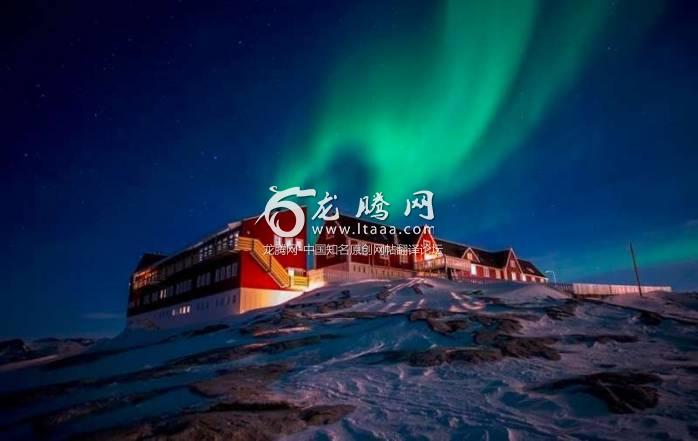[大西洋月刊]:气候变化的僵尸病——在北极融化的永久冻土层中潜藏着什么? [美国媒体]
从空中看来,格陵兰岛的海岸显得广阔而宁静。这里有数以百计的峡湾,它们的表面——一面蓝色天空和以云为底的镜子——分割着这片土地。在它们之间的空隙中,地形自行折叠着,小山压着小山,一直向下延伸到如黑曜石一般的湖泊。草皮覆盖着高山矮杨柳和因为岁月而泛白的地衣。
The Zombie Diseases of Climate Change
What lurks in the Arctic’s thawing permafrost?
气候变化的僵尸病——在北极融化的永久冻土层中潜藏着什么?
From the air, the coast of Greenland appears vast and tranquil. Hundreds of fjords, their surfaces a mirror of blue sky and cloud bottoms, divide the territory. In the gaps between them, the terrain folds over itself, hill over hill, descending into obsidian lakes. The turf is covered in the waxy pastels of alpine dwarf willows and the dull white of age-bleached lichen.
从空中看来,格陵兰岛的海岸显得广阔而宁静。这里有数以百计的峡湾,它们的表面——一面蓝色天空和以云为底的镜子——分割着这片土地。在它们之间的空隙中,地形自行折叠着,小山压着小山,一直向下延伸到如黑曜石一般的湖泊。草皮覆盖着高山矮杨柳和因为岁月而泛白的地衣。
Though an immense ice sheet sits in its interior, Greenland’s ice-free coast encompasses almost 159,000 square miles and and houses 57,000 people. In other words, it is larger than Germany with a population half the size of Topeka, Peoria, or New Haven. It is possible to stand on a hill outside the coastal town of Ilulissat and hear only the grass quaking, the harbor ice dully grinding against itself.
尽管格陵兰岛的内陆有一片巨大的冰原,但格陵兰岛的无冰海岸几乎覆盖了15万9,000平方英里的面积,这片地区居住着5万7000人。换句话说,它比德国的面积还要大,但人口却只有托皮卡、皮奥瑞亚或纽黑文的一半。站在海边小镇伊卢利萨特外的一座山丘之上,你可能只会听到草木摇摆和港口浮冰摩擦的声音。
I visited Greenland because, lately, the land here has gone soft, and disquieting things threaten to wake in it.
我去了一趟格陵兰岛,因为最近,这里的土层开始变软了,令人不安的东西有可能在里面苏醒过来。
Let me orient you. At the top of the world, there is water. Television anchors sometimes speak of the Arctic Ocean as the “polar ice cap,” but that is a contingency of temperature and a quirk of today’s climate. Consider it instead a landlocked ocean, a northern Mediterranean Sea. Surrounding it sit great landmasses—Europe, Asia, North America—and a surfeit of islands. Among the largest are Svalbard, which is due north of Norway and so dense with polar bears that everyone who strays beyond its sole settlement must carry a rifle; Novaya Zemlya, the site of the largest atomic test ever conducted; and Greenland.
让我来给你确定方向。在这个世界的顶端是一片水。电视主播有时会把北冰洋说成是“极地冰帽”,但这只是一种温度造成的偶然现象和现今气候变化造成的奇怪景象。我们可以把它看作是一个内陆海,一个北方的地中海。它周围环绕着广袤的陆地——欧洲、亚洲、北美洲和非常多的岛屿。其中最大的岛屿是斯瓦尔巴特群岛,它位于挪威北部地区,那里的北极熊分布密度非常大,以至于每一个来往于它唯一的定居点以外的人都必须携带来复枪;新地岛则是有史以来规模最大的一次核试验的试验场;此外还有格陵兰岛。
In all of these places, rich, marshy soils run from the edge of the interior ice right up to the ocean cliffs. Once, this dirt gave rise to lush ferns and open grasslands; now, after 35,000 years of frigid cold, we call them permafrost.
在所有这些地方,肥沃的沼泽土壤从内陆冰层的边缘一直延伸到海洋悬崖。这种泥土中曾经生长出了茂盛的蕨类和开阔的草地;现在,在经历了35000年的严寒之后,我们称之为永久冻土层。
Despite their name, they are not permanently, or entirely, frozen. Every winter, a sheet of ice blossoms over the Arctic sea, and the soils seize shut with frost. Then, during the long summer days, the ice breaks up and the permafrost partially thaws.
尽管被称为永久冻土层,但它并不是永久性的,也不是完全遭到冻结的。每年冬天,北冰洋上都会出现一层冰花,土壤中则布满了霜花。然后,在漫长的夏季中,冰层破裂,永久冻土层开始部分融化。
“If there are microbes infectious to humans or human ancestors, we are going to get them.”
“如果存在着可以感染人类或人类祖先的微生物,我们就将被它们感染。”
Lately, as summers have lengthened and winters have warmed, this seasonal transformation has lost its symmetry. What biologists call the permafrost’s “active layer”—the part of the dirt where microbes and other forms of life can live—now reaches farther underground, and further north, than it has for tens of thousands of years.
最近,随着夏季的延长和冬季的升温,这种季节性的转变已经失去了其对称性。被生物学家称为“活跃层”的那部分永久冻土——也就是微生物和其他形式的生命可以生活于其中的土壤部分,相比于其过去数万年内的存在范围,现在已经可以延伸到地下更深处,甚至是更北方的地区。
The newly active permafrost is packed with old stuff: dead plants, dead animals, mosses buried and reburied by dust and snow. This matter, long protected from decomposition by the cold, is finally rotting, and releasing gases into the atmosphere that could quicken the rate of global warming.
新近活跃的永久冻土里充满了古老的东西:死去的植物,死去的动物,被尘土和雪掩埋的苔藓。这些长期以来得到严寒的保护最终趋于腐烂,并释放气体进入大气层中,从而加速了全球变暖的速度。
This matter is also full of pathogens: bacteria and viruses long immobilized by the frost. Many of these pathogens may be able to survive a gentle thaw—and if they do, researchers warn, they could reinfect humanity.
这种物质中也充满了病原体:细菌和病毒长期以来被霜冻所封禁。研究人员警告称:其中的许多病原体可能能够在温暖的环境下生存下来,如果它们确实可以存活下来的话,就有可能会重新感染人类。
Climate change, in other words, could awaken Earth’s forgotten pathogens. It is one of the most bizarre symptoms of global warming. And it has already begun to happen.
换句话说,气候变化可以唤醒地球中被遗忘的病原体。这是全球变暖最奇怪的症状之一。而且这种情况已经开始出现。
The Russian botanist Dmitri Ivanovsky was just 28 when, at a scientific meeting in St. Petersburg, he presented evidence of an unexplainable phenomenon: He had found a disease with no germ.
俄罗斯植物学家德米特里·伊凡诺夫斯基在他28岁的时候便在圣彼得堡的一次科学会议上展示了一种无法解释的现象:他发现了一种不由细菌引发的疾病。
When he exposed tobacco leaves to a certain clear liquid, he could watch the leaves mottle, but he could not find the bacteria under his microscope that could explain the change. In the decades before his work—it was 1892—Louis Pasteur and other scientists had demonstrated that microscopic life could cause disease. But here was a disease with no microbe at fault. Ivanovsky said that the disease must be inherent to the gloop he had put on the leaves. He termed it a virus, from the Latin word for slime.
当他将烟叶置于某种清澈的液体中时,他可以观察树叶的斑点,但他无法在显微镜下找到可以用来解释这种变化的细菌。在他之前几十年的工作时间里,路易斯·巴斯德和其他科学家已经证明了微生物这种微观生命可以引起疾病。但这却是一种没有微生物的疾病。伊凡诺夫斯基说,这种疾病必须是他在树叶上的物质中所固有的。他把这种物质称为病毒,源于拉丁语中的“黏液”一词。
One hundred and twenty-five years later, we still use Ivanovsky’s term, but we know viruses are far stranger than he ever imagined. An individual virion, the unit of viral existence, makes many copies of itself over its life cycle, but it never does something that can be described as living. It never breathes or mates. It punctures a cell’s wall, hijacks its protein factories, and forces it to make more of itself. A single virion can make tens of thousands of copies of itself near instantly. Viruses are living nonlife, a desirous but mindless substance.
在一百二十五年后,我们仍然在使用Ivanovsky所创造的术语,但是我们知道病毒比他想象的要奇怪得多。病毒存在的单位——单独的病毒粒子在其生命周期中会产生很多的自身副本,但它从来不会表现出可以被描述为“生命”的东西的一些行为。它从不呼吸,也从不交配。它刺破了细胞的墙壁,劫持了它的蛋白质工厂,迫使它为自己制造更多的蛋白质。一个单一的病毒粒子可以在瞬间产生成千上万的副本。病毒是活的非生命体,它是一种有欲望但没有头脑的物质。
At the frontier of viral life are Jean-Michel Claverie and Chantal Abergel, two professors of microbiology at Aix-Marseilles University who happen to be married to each other. Since the turn of the century, they have established themselves as two of the world’s most famous microbe hunters. In 2002, while researching Legionnaires’ disease in their lab in Marseilles, they discovered the largest virus ever: Mimivirus, a virion so large that it could be seen under a microscope.
身处病毒生命研究的前沿的Jean-Michel Claverie和Chantal Abergel是两名来自埃克斯-马赛大学的微生物学教授,他们之前正好结为了夫妻。自本世纪初以来,他们已经成为世界上最着名的微生物猎手。2002年,在其位于马赛的实验室里研究军团病时,他们发现了史上最大的病毒:巨型病毒,这是一种非常大的病毒粒子,甚至可以在显微镜下观察到。
They have identified four more monster viruses since, all several times larger than any virion known to science before 2000. Their menagerie oozes about in a far-flung set of landscapes: one monster virus was found in a shallow lake in Australia, another lurked in a bucket of seawater hauled off the Chilean coast. A third was discovered in a woman’s contact lens.
自此之后,他们已经发现了四种更加巨大的病毒,它们的体积要比2000年之前的任何一种病毒粒子都要大好几倍。他们发现的病毒展现了一种广泛可见的景象:他们在澳大利亚的一个浅湖中发现了一种巨型病毒,还在一桶来自智利海岸的海水中发现了另一种巨型病毒。第三种巨型病毒是在一名女性的隐形眼镜中发现的。
All of these mammoth viruses infect amoebae, not people. They do not pose an infective risk to us. But they are strange substances. They rival bacteria in size; they can be seen under a microscope. They are quite durable. And some of them produce more proteins than most amoebae.
所有这些巨大的病毒感染的都是阿米巴原虫,而不是人类。它们不会对我们造成感染风险。但它们是一类奇怪的物质,在大小上可以与细菌相比拟;它们可以在显微镜下被观察到。它们的生命力非常顽强。其中一些相比于阿米巴原虫甚至能制造出更多的蛋白质。
Claverie and Abergel weren’t thinking of monster viruses when they began poking around in the permafrost. In 2013, Claverie read about a Russian team that had found a seed lodged deep in the permafrost. The fruit, buried some 125 feet below the surface, had spent thousands of years at about 20 degrees Fahrenheit, never thawing out in the wax and wane of seasons. But once warmed and placed in a pot, it sprouted waxy arms and delicate white flowers.
Claverie和Abergel在开始于永久冻土层中四处寻找时,并没有想到巨型病毒。2013年,Claverie读到了一个俄罗斯团队撰写的文章,文章称他们发现了一颗深埋在永久冻土层中的种子。这颗果实被埋在地下125英尺深的地方数千年的时间,一直处于华氏20度左右的环境中,从未从冰封中解冻出来。但是一旦环境变暖,将它放在锅里,它就会长出蜡状的枝桠和精致的白色花朵。
“The viruses we are getting [in the permafrost] are extremely abnormal.”
“我们在永久冻土层中所找到的病毒是极其不正常的。”
Claverie contacted the Russian team, explained his work with microbes, and asked for a bit of permafrost to test. The team agreed, and they mailed Claverie and Abergel a sample of the same deep-frozen core of permafrost that had contained the seed. The pair pulled a small sample onto a high-resolution microscope, brought it to room temperature, introduced an amoeba as bait, and waited.
Claverie联系了俄罗斯团队,解释了他在微生物领域的工作,并寻求获得一些永久冻土进行测试。这个团队同意了,他们寄给Claverie和Abergel一份曾经裹藏着这粒种子的永久冻土深度冷冻核心部分的样本。他们把一份小样本放在高分辨率的显微镜下观察,让它带入到室温环境下,并以一只阿米巴原虫作为诱饵,然后等待结果出现。
And then, as they watched, a virus appeared in their viewfinder: Pithovirus sibericum, a massive ovular virion that had survived 30,000 years frozen in the ice core. It was also the largest virion ever discovered.
之后,当他们观察的时候,一种病毒出现在了他们的取景器中:这是阔口罐病毒——一种巨大的卵形病毒,它在冰核中存活了3万年。它也是迄今为止发现的体型最大的病毒。
“We tried to isolate amoeba viruses without knowing they were going to be giant viruses—and a totally different type of virus than we already know appeared,” Claverie said. “It turns out the viruses we are getting [in the permafrost] are extremely abnormal, extremely fancy.”
Claverie说:“我们试图分离出阿米巴原虫病毒,但不知道它们会是如此巨大的病毒,而且是一种迄今为止我们所不知道的病毒。事实证明,我们在永久冻土层中找得的病毒是极其不正常的,它非常奇特。”
Claverie and Abergel’s viruses aren’t a threat to humanity—yet. But human pathogens have also survived freezing and thawing in the permafrost. Last summer, an outbreak of anthrax in Siberia infected dozens of people and killed one child. The vector of disease is thought to be the thawing and decaying carcass of a reindeer killed in 1941.
Claverie和Abergel的病毒对人类来说并不是一个威胁。但是人类的病原体也在永久冻土层中存活了下来。去年夏天,在西伯利亚爆发的炭疽热感染了数十人,并导致了一名儿童死亡。疾病的媒介被认为是在1941年被杀死的一头驯鹿的融化且腐烂的尸体。
And a team of Canadian scientists recently found a strain of bacteria, Paenibacillus, in a cave in New Mexico that had been closed off for more than 4 million years. Though harmless to humans, the ancient bacteria was resistant to most clinical antibiotics, including most of the newest and most aggressive. The discovery suggested that bacteria can survive the most exotic and remote environments.
最近,一队加拿大科学家在新墨西哥州的一个洞穴里发现了一种细菌,这种细菌已经被封闭了超过400万年。虽然对人类无害,但这种古老的细菌对大多数的临床抗生素都有耐药性,甚至包括最新和最具攻击性的抗生素。这一发现表明:细菌可以在最奇异和最偏远的环境中生存下去。
“At once, you are going to excavate 16 million tons of permafrost that has not been moved in a million years.”
“你可以一次性挖掘出1600万吨的永久冻土,而这些永久冻土在过去100万年里都没有被移动过。”
Researchers are continuing to test the limits of pathogens. Reportedly, a Soviet microbiology lab revived bacteria from the permafrost in the 1980s, but its paper went little noticed. Claverie is traveling to Siberia this year to core even deeper into the soil, to prove that viruses can survive being thawed out after a million years.
研究人员还在继续测试病原体的极限。据报道,上世纪80年代苏联的一个微生物实验室从永久冻土层中恢复了细菌,但是它的论文几乎没有引起注意。Claverie今年将前往西伯利亚,深入到更深层的土壤中进行研究,以证明病毒是可以在100万年后被解冻的。
“We’re trying to go deeper and deeper in our sampling, to demonstrate that it is possible that viruses could survive—amoeba viruses. We are not going to try to revive human viruses, of course, we are not crazy,” he said.
他说:“我们正试图对我们的采样样本进行更深入的研究,以证明病毒——也就是阿米巴原虫病毒——是有可能存活下来的。我们当然不会试图复活与人类相关的病毒,我们还没疯掉。”
He already frets about what climate change will unlock in the permafrost, especially when humans help it along.
他已经为气候变化导致的永久冻土层中被释放的东西而烦恼,尤其是在人类在这一过程中起到了推动作用。
Take Greenland, for instance. Right now, the island is a territory of Denmark, the country that colonized it three centuries ago. Greenland is slowly severing itself from Europe—in 2009, its government took over every government function from Denmark except defense and foreign policy. Denmark still pays out a block grant to Greenland every year equal to roughly two-thirds of its government budget, but independence will likely mean giving that up. To fill that eventual budget hole, Greenland has explored opening six new mines across the country. Greenland abounds in minerals—the island’s south contains the largest reserve of untapped rare-earth elements on the planet—but the Arctic’s dangerous seas and extreme temperatures have ensured they’ve never been mined. Climate change will solve both those problems, so to speak.
拿格陵兰举个例子。现在,这个岛是丹麦的领土,后者在三个世纪前殖民了它。格陵兰正在慢慢地脱离欧洲——在2009年,它的政府从丹麦那里接管了除国防和外交之外的所有政府职能。丹麦每年仍向格陵兰支付一大笔资金,这相当于格陵兰政府预算的三分之二,但独立可能意味着要放弃这笔钱。为了填补这个最终的预算缺口,格陵兰已经在寻求开发全国范围内的6个新矿。格陵兰岛有丰富的矿产资源——这个岛屿的南部拥有世界上储量最大的未开发的稀土元素,但北极的危险海域和极端温度导致了它们从未被开采过。可以说,气候变化将解决这两个问题。
In a paper this year in the European Journal of Internal Medicine, Claverie worried about the pathogenic consequences of opening the Arctic Ocean, specifically around Siberia and the Russian Arctic, to commercial traffic.
在今年的《欧洲内科杂志》上发表的一篇论文中,Claverie担心开放北冰洋商贸运输在病原方面所会造成的后果,特别是在西伯利亚和俄罗斯所属的北冰洋地区。
“We know, and the Russians know, there are a lot of resources there. Very precious metals, rare-earths, petrol, there is gas and gold,” he told me. Greenland is not separate from these pressures.
他告诉我:“我们知道,俄罗斯人也知道,那里有很多资源。那里有非常珍贵的金属、稀土、石油资源,还有天然气和黄金”。格陵兰岛也没有摆脱这些压力。
Getting at the minerals and petroleum deposits throughout the Arctic, he says, will require moving a lot of permafrost—an amount properly measured in millions of tons. “At once, you are going to excavate 16 million tons of permafrost that has not been moved or perturbed in a million years of time,” he said.
他说,要想在北极地区开采矿产和石油,需要移动很多的永久冻土层——总数可能达到数百万吨。他说:“你可以一次性挖掘出1600万吨的永久冻土,而这些永久冻土在过去100万年里都没有被移动过。”
He imagines towering heaps of rotting permafrost stacked up next to mining cabins, their contents open to the sun and air and summer rain. “We are really reaching places where, if there are microbes infectious to humans or human ancestors, we are going to get them,” he says.
他说:“他想象着高耸的堆积在一起的永久冻土,它们被堆积在采矿小屋旁边,它们内部的东西敞开面对着阳光、空气和夏季的雨水。我们确实已经到了这样一种境地——如果有微生物对人类或人类祖先有传染性,我们就会被它们传染。”
If one of these contagions does get loose in Greenland, Luit Penninga will be one of the first men to deal with it. He is the lead surgeon at Ilulissat Hospital in Greenland. His office looks out across Disko Bay, a gray sea 200 miles north of the Arctic Circle disturbed by azure-edged icebergs and the occasional breaching tail of a humpback whale.
如果其中的一种传染病源在格陵兰岛被释放,Luit Penninga将是第一批处理这一问题的人之一。他是格陵兰伊卢利萨特医院的首席外科医生。从他的办公室可以俯瞰位于北极圈以北200英里处的一片灰色的海洋,这片海域中常会出现一些有棱有棱的冰山,偶尔还会看到一头座头鲸的尾巴。
His entire life is dictated by the scarcity of Arctic medicine. The night before I met Penninga, he boarded a red helicopter and rode it across the bay to meet a woman suffering a pregnancy out of the womb. She lives in the village of Uummannaq, population 1,200, which has no doctors of its own. He helped her board the helicopter, attended to her through the flight, and—when the helicopter landed at Ilulissat Hospital—operated on her. It was successful. Early the next morning he invited me to visit the hospital. When I meet him, he is gentle and calm.
他的整个人生都奉献给了北极地区稀缺的医学事业。在我遇到Penninga的前一天晚上,他登上了一架红色的直升飞机,搭乘它穿过海湾去照顾一个怀孕的女人。她住在乌玛纳克村中,那里有1200人定居,但没有自己的医生。他帮助她登上了直升飞机,在飞行过程中一路照料她,当直升机降落在伊卢利萨特医院之后,他对这个女人实施了手术。手术是成功的。第二天一早,他邀请我去医院。当我见到他时,他显得温和而冷静。
Ilulissat Hospital (Malik Niemann / Courtesy of Ilulissat Hospital)
伊卢利萨特医院
Health care in Greenland is socialized—all hospitals are state-owned and all medical care and prescription drugs are free—and the vast country is split into regions. Since Penninga leads health care in Ilulissat, he oversees human health across the entire northwest half of the world’s largest island—from Ilulissat, the country’s third-largest city, to Qaanaaq, a small town of 650 that overlooks the Arctic Ocean. Seventeen thousand people live in the region, mostly in small villages accessible only from boat or helicopter, spread out over an area larger than France.
格陵兰的医疗保健系统是社会主义化的,所有的医院都归国有,所有的医疗和处方药都是免费的,这个幅员辽阔的国家被分割成多个地区。自从Penninga领导了伊卢利萨特医院的医疗保健系统以来,他便监管了这个世界上最大岛屿的整个西北部分——从这个国家的第三大城市伊卢利萨特到俯瞰着北冰洋、只有650人的小镇卡纳克。在该地区居住的人有1.7万,他们主要居住在只有乘船或直升机才能到达的小村庄,分布在一块比法国还要大的地区中。
Penninga must sometimes take the three-hour flight between Qaanaaq and Ilulissat, a distance of more than 700 miles (1173 km). It costs $1400. From Qaanaaq, it’s another hour-long helicopter ride to reach some of the smallest villages, where people hunt seal and walrus as their ancestors have for generations. These transportation costs add up: In any year, between 10 and 15 percent of Greenland’s national health budget is spent on transportation costs alone.
Penninga有时必须在卡纳克和伊洛里萨之间进行三小时的飞行,距离超过700英里(1173公里)。这趟旅程需要花费1400美元。从卡纳克出发,再搭乘一小时的直升机可以到达一些最小的村庄,那里的人们就像他们的祖先一样,捕猎海豹和海象。如果将这些运输成本加起来了,可以发现,不管在哪一年,格陵兰国家医疗预算的10%到15%都花在了运输成本上。
Penninga treats snowmobile and dogsled accidents, appendicitis and chlamydia and pneumonia. Many of the worst ailments are bacterial: A particularly aggressive form of ear infection, which seems endemic to Greenland, can leave holes in kids’ eardrums that last for years, permanently inhibiting their performance in school. The island also seems to have its own form of sepsis, which doctors learn to fear after a couple years of working there. “Some people can have a very short course of disease—they develop sepsis, very shortly come in, and die,” he said.
Penninga需要治疗机动雪橇和狗拉雪橇所导致的意外创伤、阑尾炎、衣原体病和肺炎。许多最严重的疾病都是由细菌引起的:一种特别具有侵袭性的耳膜感染似乎是格陵兰岛特有的,它会在孩子的耳膜上留下一个洞,持续数年之久,从而永久性地压抑了他们在学校的表现。该岛似乎也有自己特有的败血症,医生在那里工作了几年之后就学会了害怕。他说:“有些人会有很短的病程中发展出败血症,这些症状很快就会出现,然后他就会死去。”
When I asked him about the zombie pathogens, he laughed and nodded. “They say that, yes,” he told me. Penninga has enough problems.
当我问他关于僵尸的病原体的问题时,他笑了笑,点了点头。他告诉我:“他们说到过,是的”。Penninga有一大堆的问题。
Even more worrisome are the microbes we don’t know.
更令人担忧的是我们不知道的微生物。
Some of the microbes lurking in the permafrost may be familiar: adversaries that humanity already knows and believes it has defeated. The World Health Organization brags that it has eradicated smallpox, for instance—other than the stores in the United States and Russia—but Claverie warns that it could well have survived in the tundra.
潜伏在永久冻土中的一些微生物可能是我们所熟悉的:人类已经知道并相信它已经被打败了。世界卫生组织夸口说它已经根除了天花,除开美国和俄罗斯研究所中所储藏的样本,但是Claverie警告称:它很可能在冻土地带中存活了下来。
Even more worrisome are the microbes we don’t know. “No one really understands why Neanderthals went extinct,” Claverie said. Sometimes, he catches himself when talking about these possible permafrost-locked diseases—they may have threatened humans or human relatives in the past, he’ll say. Then, he’ll change tense, emphasizing that they could do so again.
更令人担忧的是我们所不知道的微生物。Claverie说:“没有人真正了解尼安德特人为什么灭绝了。”有时,他会在谈论这些可能存在的被永久冻土困住的疾病时突然想到,这些疾病过去可能威胁过人类或人类的近亲。然后,他又改变了这句话的时态,强调它们可以再次这样做。
Two weeks after I left Greenland, a patch of permafrost not far from Penninga’s office burst into flame. The press marveled around the world: a wildfire on the tundra. It raged for weeks as authorities tried to figure out how to keep it from causing anyone harm. The problem itself, the logistics involved in addressing it, required a response no one had anticipated or practiced for. Eventually, rain put it out.
在我离开格陵兰的两周后,离Penninga办公室不远的一处永久冻土突然燃烧了起来。世界各地的媒体都惊叹不已:这是永久冻土地带上的一场野火。这一问题持续了数周,当局试图弄清楚如何防止它给任何人造成伤害。这个问题本身便涉及到解决它的逻辑,需要一个没有人预料到或实践过的回应。最后,降雨浇灭了这场火。
Such emergencies—those that overwhelm our understanding of “known knowns”—are among the most unsettling portents of climate change. Whether the emergencies of the coming century arrive in the form of fires, or floods, or plagues that rise invisibly from the ground, they’re likely to become more and more extreme and less and less familiar—a fantastical parade of crises we will be shocked to find ourselves battling. Even in its quietest places, the world will become newly hostile.
这样的紧急事件——那些压倒我们对“已知知识”的理解的事件——是气候变化过程中最令人不安的征兆之一。不管下个世纪的紧急事件是如何以火灾、洪水或瘟疫的形式出现的,它们都可能变得越来越极端,越来越不熟悉,我们将会震惊地发现自己正在与之战斗。即使是在最安静的地方,世界也会变得充满敌意。
版权声明
我们致力于传递世界各地老百姓最真实、最直接、最详尽的对中国的看法
【版权与免责声明】如发现内容存在版权问题,烦请提供相关信息发邮件,
我们将及时沟通与处理。本站内容除非来源注明五毛网,否则均为网友转载,涉及言论、版权与本站无关。
本文仅代表作者观点,不代表本站立场。
本文来自网络,如有侵权及时联系本网站。
图文文章RECOMMEND
热门文章HOT NEWS
-
1
Why do most people who have a positive view of China have been to ...
- 2
- 3
- 4
- 5
- 6
- 7
- 8
- 9
- 10
推荐文章HOT NEWS
-
1
Why do most people who have a positive view of China have been to ...
- 2
- 3
- 4
- 5
- 6
- 7
- 8
- 9
- 10














